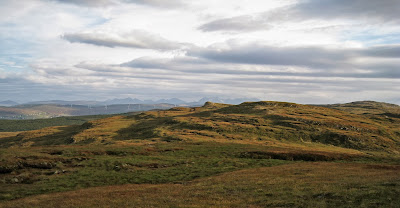As in much of the Highlands, we have our pine, spruce and larch plantations on Skye, but we have some woodland too. Also, trees have often been planted on crofts to provide some protection from the wind. Even on the open moorland, a gorge or hillside can provide enough shelter to allow tough little trees to become established.
This post adds more pictures to the post 'Trees and Storms on Skye', which I published earlier today on my Skye Calling blog - http://skyecalling.blogspot.co.uk/
The purpose of this blog is to publish some of our pictures of the Isle of Skye,
(CLICK ANY PICTURE TO VIEW A FULL-SIZE GALLERY)
Thursday, 5 December 2013
Saturday, 16 November 2013
November Skye
Autumn turns to winter quickly here. The moors are brown now, and there is snow on the Cuillin, though we are yet to get any frosts here at close to sea-level. Below I am posting a selection of photographs, mostly taken by Sue, over the last few years in the month of November...
Wednesday, 23 October 2013
Skye shielings
What's a shieling?
A shieling was a temporary village used mostly by the younger people of a township, who took the community's livestock to to graze on the hills during the summer months when the land around the permanent housing was in use for vegetable production.
Shielings are almost always built below a rocky crag which provides the handy building stone, as well as the possibility of shelter from the worst of the summer storms. They are also always located close to a burn, necessary for a water supply.
Within a shieling, a number of small dwellings were built. Sometimes just a couple of dwellings, up to as many as seventy or even more, but mostly between ten and twenty. The modern day equivalent would be a camp site of tents. The shieling dwellings, today known as huts, consisted of a low, near-circular stone wall with no window, creating a single cell. Double cell huts, with two interconnecting rooms were also built, and are common. The roof would have been of a heather thatch, which would have been renewed each year. But the stone walls lasted for many years, and indeed, once thatched, some of the currently existing ruins could be habitable today, though most remain as little more than grassy bumps in the moorland. It is also likely that some shieling huts had turf walls, so there is no longer any evidence at all of their existence.
I am not aware of any original stone built shieling huts that are not ruined. However, there are very many ruined sites, some marked on Ordnance Survey maps, but many more that are not. Below, are my photos of just a few of the remains I have come across on the Skye moors and hills....
A shieling was a temporary village used mostly by the younger people of a township, who took the community's livestock to to graze on the hills during the summer months when the land around the permanent housing was in use for vegetable production.
Shielings are almost always built below a rocky crag which provides the handy building stone, as well as the possibility of shelter from the worst of the summer storms. They are also always located close to a burn, necessary for a water supply.
Within a shieling, a number of small dwellings were built. Sometimes just a couple of dwellings, up to as many as seventy or even more, but mostly between ten and twenty. The modern day equivalent would be a camp site of tents. The shieling dwellings, today known as huts, consisted of a low, near-circular stone wall with no window, creating a single cell. Double cell huts, with two interconnecting rooms were also built, and are common. The roof would have been of a heather thatch, which would have been renewed each year. But the stone walls lasted for many years, and indeed, once thatched, some of the currently existing ruins could be habitable today, though most remain as little more than grassy bumps in the moorland. It is also likely that some shieling huts had turf walls, so there is no longer any evidence at all of their existence.
I am not aware of any original stone built shieling huts that are not ruined. However, there are very many ruined sites, some marked on Ordnance Survey maps, but many more that are not. Below, are my photos of just a few of the remains I have come across on the Skye moors and hills....
Saturday, 5 October 2013
Thursday, 19 September 2013
Skye Rainbows
Having four different kinds of weather in one day isn't all that unusual on Skye, so sun and rain at the same time happens quite a bit, which often results in a stunning rainbow...
Sunday, 1 September 2013
Skye's Inland Lochs
Skye's sea lochs and coastal scenery may be spectacular, but the island has many freshwater lochs and lochans too, most of which provide rich photo opportunities, and often lie in peaceful and secluded settings.
Subscribe to:
Posts (Atom)

















































